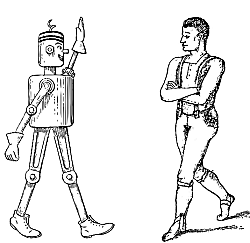 We need to talk about sexbots. It seems (according to the Daily Mail – via MLU) that buyers of the new Pepper robot pal are being asked to promise they will not sex it up the way some naughty people have been doing; putting a picture of breasts on its touch screen and making poor Pepper tremble erotically when the screen is touched.
We need to talk about sexbots. It seems (according to the Daily Mail – via MLU) that buyers of the new Pepper robot pal are being asked to promise they will not sex it up the way some naughty people have been doing; putting a picture of breasts on its touch screen and making poor Pepper tremble erotically when the screen is touched.
Just in time, some academics have launched the Campaign against Sex Robots. We’ve talked once or twice about the ethics of killbots; from thanatos we move inevitably to eros and the ethics of sexbots. Details of some of the thinking behind the campaign are set out in this paper by Kathleen Richardson of De Montfort University.
In principle there are several reasons we might think that sex with robots was morally dubious. We can put aside, for now at least, any consideration of whether it harms the robots emotionally or in any other way, though we might need to return to that eventually.
It might be that sex with robots harms the human participant directly. It could be argued that the whole business is simply demeaning and undignified, for example – though dignified sex is pretty difficult to pull off at the best of times. It might be that the human partner’s emotional nature is coarsened and denied the chance to develop, or that their social life is impaired by their spending every evening with the machine. The key problem put forward seems to be that by engaging in an inherently human activity with a mere machine, the line is blurred and the human being imports into their human relationship behaviour only appropriate to robots: that in short, they are encouraged to treat human beings like machines. This hypothetical process resembles the way some young men these days are disparagingly described as “porn-educated” because their expectations of sex and a sexual relationship have been shaped and formed exclusively by what we used to call blue movies.
It might also be that the ease and apparent blamelessness of robot sex will act as a kind of gateway to worse behaviour. It’s suggested that there will be “child” sexbots; apparently harmless in themselves but smoothing the path to paedophilia. This kind of argument parallels the ones about apparently harmless child porn that consists entirely of drawings or computer graphics, and so arguably harms no children.
On the other side, it can be argued that sexbots might provide a harmless, risk-free outlet for urges that would otherwise inconveniently be pressed on human beings. Perhaps the line won’t really be blurred at all: people will readily continue to distinguish between robots and people, or perhaps the drift will all be the other way: no humans being treated as machines, but one or two machines being treated with a fondness and sentiment they don’t really merit? A lot of people personalise their cars or their computers and it’s hard to see that much harm comes of it.
Richardson draws a parallel with prostitution. That, she argues, is an asymmetrical relationship at odds with human equality, in which the prostitute is treated as an object: robot sex extends and worsens that relationship in all respects. Surely it’s bound to be a malign influence? There seem to be some problematic aspects to her case. A lot of human relationships are asymmetrical; so long as they are genuinely consensual most people don’t seem bothered by that. It’s not clear that prostitutes are always simply treated as objects: in fact they are notoriously required to fake the emotions of a normal sexual relationship, at least temporarily, in most cases (we could argue about whether that actually makes the relationship better or worse). Nor is prostitution simple or simply evil: it comes in many forms from many prostitutes who are atrociously trafficked, blackmailed and beaten, through those who regard it as basically another service job, through to some few idealistic practitioners who work in a genuine therapeutic environment. I’m far from being an advocate of the profession in any form, but there are some complexities and even if we accept the debatable analogy it doesn’t provide us with a simple, one-size-fits-all answer.
I do recognise the danger that the line between human and machine might possibly be blurred. It’s a legitimate concern, but my instinct says that people will actually be fairly good at drawing the distinction and if anything robot sex will tend not to be thought of either as like sex with humans or sex with machines: it’ll mainly be thought of as sex with robots, and in fact that’s where a large part of the appeal will lie.
It’s a bit odd in a way that the line-blurring argument should be brought forward particularly in a sexual context. You’d think that if confusion were to arise it would be far more likely and much more dangerous in the case of chat-bots or other machines whose typical interactions were relatively intellectual. No-one, I think, has asked for Siri to be banned.
My soggy conclusion is that things are far more complex than the campaign takes them to be, and a blanket ban is not really an appropriate response.



